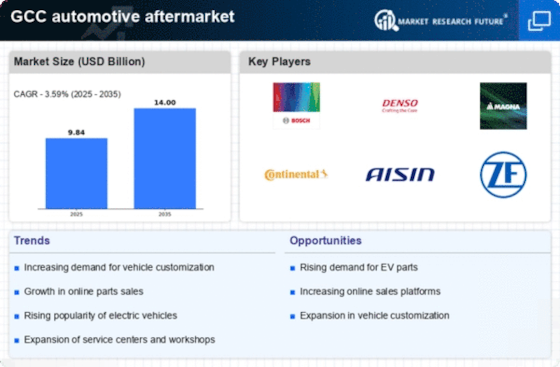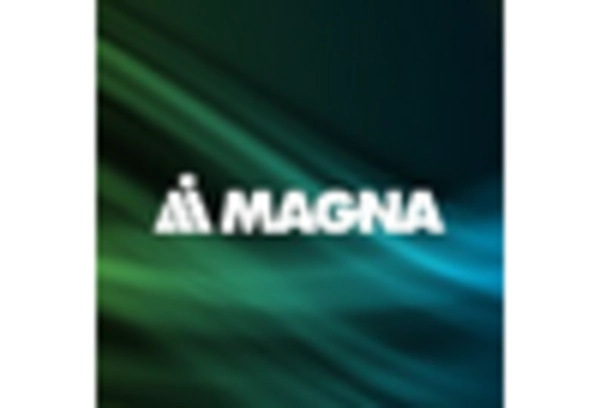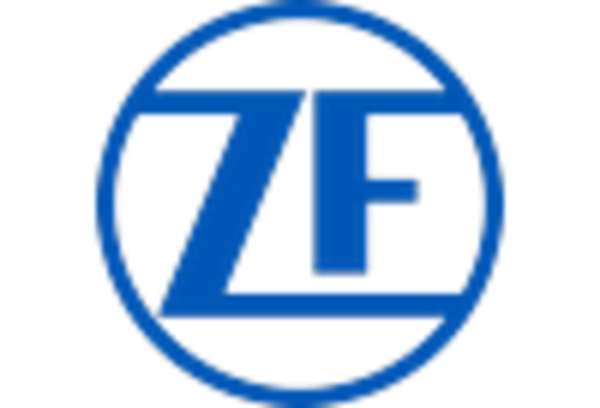Increasing Vehicle Ownership
The automotive aftermarket market in the GCC is experiencing growth due to the rising vehicle ownership rates. As more individuals acquire vehicles, the demand for aftermarket products and services escalates. In 2025, vehicle ownership in the GCC is projected to reach approximately 30 million units, indicating a growth of around 5% from previous years. This surge in ownership drives the need for maintenance, repairs, and enhancements, thereby bolstering the automotive aftermarket market. Additionally, the increasing disposable income among consumers allows for greater spending on aftermarket accessories and services, further stimulating market expansion. The automotive aftermarket market is likely to benefit from this trend as vehicle owners seek to personalize and maintain their vehicles, leading to a robust demand for various aftermarket solutions.
Regulatory Changes and Standards
Regulatory changes and evolving standards in the automotive sector are shaping the automotive aftermarket market. Governments in the GCC are implementing stricter regulations regarding vehicle emissions and safety, which necessitates the adoption of compliant aftermarket products. In 2025, it is expected that around 70% of vehicles will need to meet new environmental standards, driving demand for eco-friendly aftermarket solutions. This shift presents both challenges and opportunities for businesses within the automotive aftermarket market, as they must adapt to these regulations while also innovating to meet consumer expectations. Companies that can effectively navigate these changes are likely to gain a competitive edge, positioning themselves favorably in the evolving landscape of the automotive aftermarket market.
Expansion of Distribution Channels
The automotive aftermarket market is witnessing an expansion of distribution channels, which is facilitating greater access to aftermarket products and services. In the GCC, the rise of both physical and online retail outlets is making it easier for consumers to obtain necessary parts and accessories. By 2025, it is anticipated that online sales will account for approximately 25% of the total aftermarket sales in the region, reflecting a shift in consumer purchasing behavior. This diversification of distribution channels allows for increased competition and better pricing for consumers, ultimately benefiting the automotive aftermarket market. As more players enter the market, consumers are likely to enjoy a wider variety of options, enhancing their overall purchasing experience.
Technological Integration in Vehicles
The integration of advanced technologies in vehicles is significantly influencing the automotive aftermarket market. As vehicles become more sophisticated, equipped with features such as advanced driver-assistance systems (ADAS) and infotainment systems, the need for specialized aftermarket products and services increases. In 2025, it is estimated that around 40% of vehicles in the GCC will be equipped with such technologies, creating a demand for compatible aftermarket solutions. This trend presents opportunities for businesses to innovate and offer products that enhance vehicle performance and safety. The automotive aftermarket market is likely to see a rise in demand for high-tech components and services, as consumers seek to upgrade their vehicles with the latest technological advancements.
Growing Awareness of Vehicle Maintenance
There is a notable increase in consumer awareness regarding the importance of regular vehicle maintenance, which is positively impacting the automotive aftermarket market. As drivers become more informed about the benefits of maintaining their vehicles, they are more likely to invest in aftermarket services and products. In 2025, it is projected that around 60% of vehicle owners in the GCC will prioritize regular maintenance, leading to a surge in demand for parts and services. This trend is further supported by the proliferation of information available through digital platforms, which educates consumers on the significance of vehicle upkeep. Consequently, the automotive aftermarket market is expected to thrive as consumers actively seek out maintenance solutions to prolong the lifespan and performance of their vehicles.

















Leave a Comment